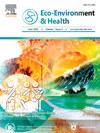热浪和臭氧导致的非意外死亡率的寡妇差异
IF 17.6
引用次数: 0
摘要
新出现的证据表明,热浪和臭氧(O3)导致死亡风险增加。由于丧偶是一种常见的事件,可以增加个体对环境的易感性,因此阐明热浪和O3导致的死亡率的丧偶差异是非常重要和有趣的。因此,我们在2015-2021年期间对中国江苏省的1,214,763例非意外死亡进行了病例交叉研究,以调查暴露于热浪和臭氧与丧偶状态死亡率的独立和交互关联。网级热浪由视温度阈值和持续时间的多种组合来定义。使用经过验证的网格数据集评估住宅热浪和O3暴露。条件逻辑回归模型应用于加性相互作用的暴露-反应分析和评价。暴露于热浪和臭氧与丧偶者死亡率的增加显著相关(热浪的优势比为1.25;O3,每四分位数范围增加1.06)和已婚受试者(1.08;1.03),丧偶受试者的相关性更高。热浪与O3之间存在显著的协同相互作用,在丧偶受试者中更强(相互作用的相对超额赔率,0.14比0.03)。在丧偶和已婚人群中,热浪、O3污染及其复合事件导致的死亡分别高达6.43%和3.56%。我们的研究结果表明,丧偶的个体更容易受到热浪和臭氧的影响,并强调有必要考虑与丧偶差异相关的差异,以防止因热浪和臭氧暴露导致的过早死亡。本文章由计算机程序翻译,如有差异,请以英文原文为准。

Widowhood disparities in nonaccidental mortality attributable to heat waves and ozone
Emerging evidence suggests that heat waves and ozone (O3) contribute to increased mortality risks. Since widowhood is a common event that can increase individuals' susceptibility to the environment, it is of great importance and interest to elucidate the widowhood disparity in mortality attributable to heat waves and O3. We therefore conducted a case-crossover study of 1,214,763 nonaccidental deaths in Jiangsu Province, China, during 2015–2021 to investigate the independent and interactive associations of exposure to heat waves and O3 with mortality by widowhood status. Grid-level heat waves were defined by multiple combinations of apparent temperature thresholds and durations. Residential heat waves and O3 exposures were assessed using validated grid datasets. Conditional logistic regression models were applied for exposure-response analyses and evaluations of additive interactions. Exposure to heat waves and O3 was significantly associated with increased odds of mortality in both widowed (odds ratio for heat waves, 1.25; O3, 1.06 per interquartile range increase) and married subjects (1.08; 1.03), and these associations were higher in widowed subjects. A significant synergistic interaction was observed between heat waves and O3, which was stronger in widowed subjects (relative excess odds due to interaction, 0.14 vs. 0.03). Up to 6.43% and 3.56% of deaths were attributable to heat waves, O3 pollution, and their compound events in widowed and married subjects, respectively. Our findings suggest that widowed individuals are more susceptible to heat waves and O3 and highlight the need to consider differences associated with widowhood disparities in preventing premature deaths due to heat waves and O3 exposures.
求助全文
通过发布文献求助,成功后即可免费获取论文全文。
去求助
来源期刊

Eco-Environment & Health
环境科学与生态学-生态、环境与健康
CiteScore
11.00
自引率
0.00%
发文量
18
审稿时长
22 days
期刊介绍:
Eco-Environment & Health (EEH) is an international and multidisciplinary peer-reviewed journal designed for publications on the frontiers of the ecology, environment and health as well as their related disciplines. EEH focuses on the concept of “One Health” to promote green and sustainable development, dealing with the interactions among ecology, environment and health, and the underlying mechanisms and interventions. Our mission is to be one of the most important flagship journals in the field of environmental health.
Scopes
EEH covers a variety of research areas, including but not limited to ecology and biodiversity conservation, environmental behaviors and bioprocesses of emerging contaminants, human exposure and health effects, and evaluation, management and regulation of environmental risks. The key topics of EEH include:
1) Ecology and Biodiversity Conservation
Biodiversity
Ecological restoration
Ecological safety
Protected area
2) Environmental and Biological Fate of Emerging Contaminants
Environmental behaviors
Environmental processes
Environmental microbiology
3) Human Exposure and Health Effects
Environmental toxicology
Environmental epidemiology
Environmental health risk
Food safety
4) Evaluation, Management and Regulation of Environmental Risks
Chemical safety
Environmental policy
Health policy
Health economics
Environmental remediation
 求助内容:
求助内容: 应助结果提醒方式:
应助结果提醒方式:


